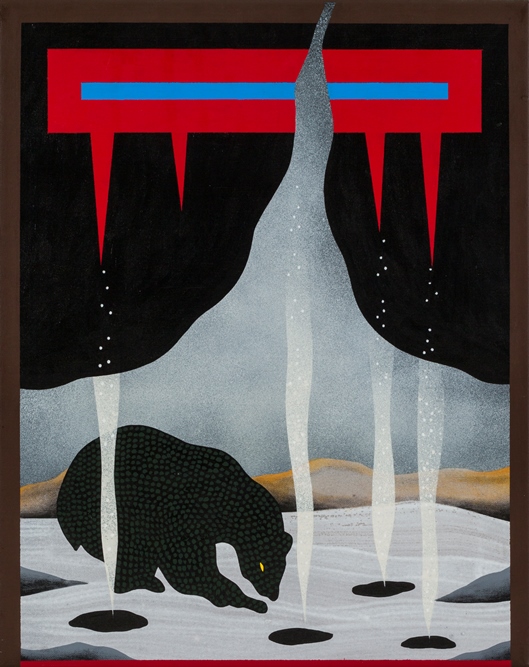Frodo Mikkelsen was a self-taught artist who lived and worked in Copenhagen. He started making graffiti at the age of ten and this is evident in his paintings today, which are characterised by simple figures in strong colours. At Nuuk Art Museum, there are three works by Mikkelsen with the cryptic titles: Food pits… (Madhuller…), Black polar bear in ice cave… (Sort isbjørn i isgrotte…) and When the ice is gone, there’s food… (Når isen er væk, er der serveret…).
The figures in the paintings are easily recognisable and clearly distinguishable from each other; for example, we see a bear, a whale, a tree, a snow landscape. But not all elements are easily recognisable; despite the clear line, there are also cryptic elements, such as the floating, colourful boxes. These elements catch our attention because we don’t immediately recognise them.
Typical for Mikkelsen, all three works are centred around an animal. The animals are one of Mikkelsen’s ‘tags’, as he called them. In the world of graffiti, a tag is a kind of signature, and this is also the function Mikkelsen assigned to ‘tags’ in his works. The stylised figures recur from piece to piece, along with the more abstract elements such as the painted fields, which means that we can quickly decode the works as being by the same artist – thus acting as his ‘signature’.
The works also seem to be part of a comic book universe due to their graphic expression. It’s as if the paintings are one image in a comic book, and we have to fill in the rest ourselves. Typically for Mikkelsen, all the titles end with three dots, which suggests that the viewer continues the story. For example, in When the ice is gone, there’s food… Here we see a whale that appears to be bobbing on a rocky outcrop. Behind it, a hilly landscape towers above the whale. Perhaps the whale is stranded on the seabed – but if so, where has the water gone? The whale is enveloped in blood-red flames – perhaps because, as the title suggests, it is the one to be served? In the deserted landscape, however, you might wonder who is being served.
Similarly, the other two works by Mikkelsen are also deserted, but in both we see the same animal: the polar bear. The polar bear is depicted in the works as a mighty creature; in Black polar bear in ice cave… it raises itself over the surroundings, while in Food pits… it is hunting. For Mikkelsen, the polar bear was the king of the ice. Mikkelsen never visited Greenland himself, despite having always been fascinated by the country. However, he had flown over Greenland countless times, and from those flights, he had never seen houses, only mountains and ice: “So the fantasy has always been that it is desolate, oh beautiful and that the animals rule”.
The works are thus an expression of Mikkelsen’s fantasies about the Greenland he had only heard about and seen from a distance; a Greenland where animals rule the deserted landscape.
“Behind the Art – Frodo Mikkelsen!” is written by Laila Lund Altinbas. 2018.

